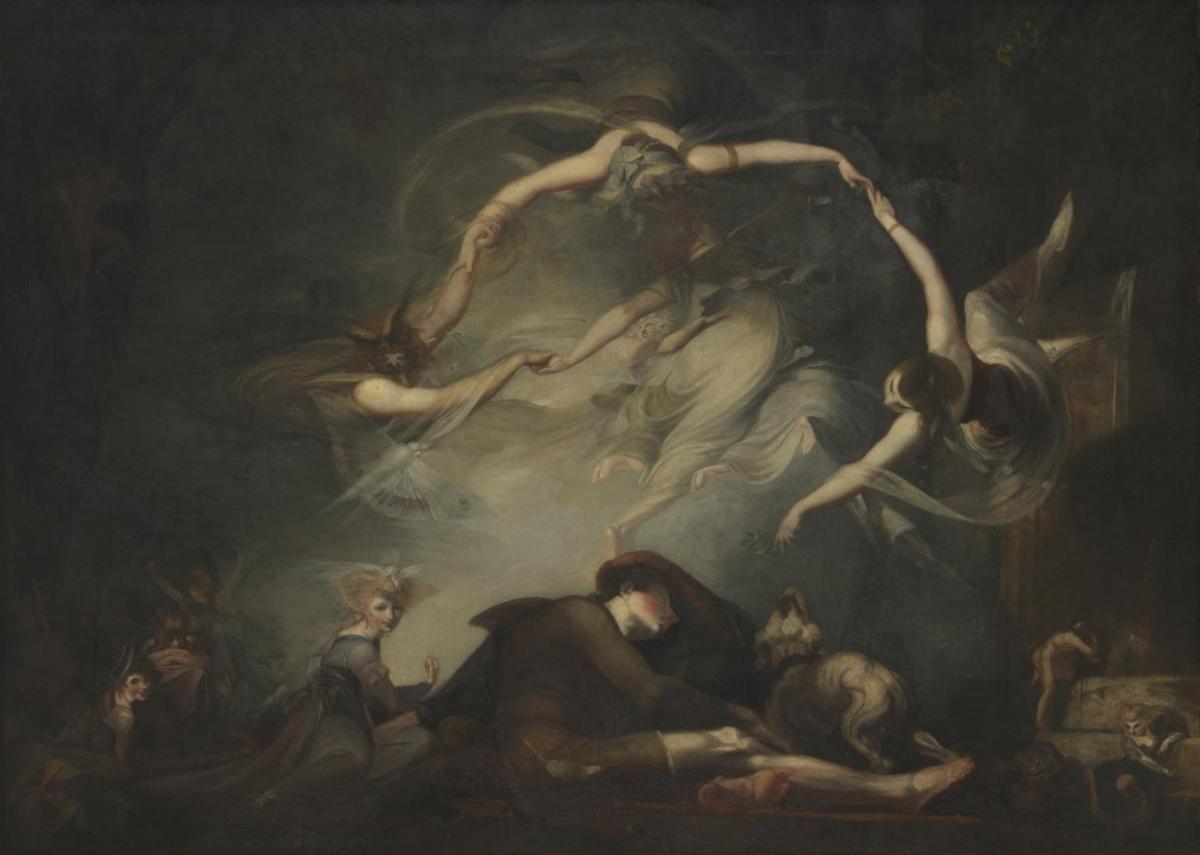Inspired by the poem, Paradise Lost by John Milton, The Shepherd's Dream was painted by Henry Fuseli in 1793. The painting is meant to represent a moment in Paradise Lost wher Milton compares the minions of Satan (Fallen Angels) in the hall of Pandemonium - which was the central city of Hell in the poem - to that of spirtes and fairies who would seduce and bewitch passing travelers with their music:
"Whose midnight revels by the forest side
Or fountain some bleated peasant sees
Or dreams he sees, while over head the moon
Sits abritress, and nearer to the Earth
Wheels her pale course, they on their mirth and dance
intent with jocund music charm his ear;
At once with joy and fear his heart rebounds.
- Paradise Lost, John Milton
What is worth noting about this painting - in all its Gothic revelry - is the hidden figures that lurk in the darkened corners of the painting. Using the technique known as Chiaroscuro, Fuseli draws the eye to the center of the painting where a band of beautiful fairies flutter above a peasant man and his dog, bewitching the poor traveler to sleep. However, if you look to the lower right corner we see a small figure of a woman who some have claimed is meant to represent Queen Mabs; in some folklore she is seen as a benevelont creature and is the mischervious queen of the faries. But darker depicitons of her exist, bestowing upon her the title Queen of Nighmares. If you peer closer you will see what could be a depiction of an incubus, connected to Queen Mabs by a heavy chain. One of the fairies, swirling above the sleeping shepherd, touches him with her wand to keep him in his slumber.
It is interesting to note the context in which the 'fairies'/women are portrayed in comparison with the way that the shepherd/men are portrayed in this painting. The women are bewitching the shepherd and seducing him to dark dreams that he has no control over. In Paradise Lost and the biblical stories of Genesis, Eve is also the destroyer of Man's innocence. This seems to be a common theme in the literature that we have been reading throughout our class. For instance, in Austen's novels - Mansfield Park and Northanger Abbey - we have the portrayal of the good woman who succeeds in conforming the expected societal role placed on them (i.e. proper manners, fullfilling men's wishes, and marrying young). Then, we have the heroines of Austen's novels who can be considered stronger female archtypes that do not conform to the status quo set for women at the time. I see the women of the painting in similar context; it is as if the fairies and their Queen are the image that men of that time period had of women who dared to think for themselves; or women who dared to go against society's expectations of them. We see this in Mansfield Park when our Heroine denies the marriage proposal Henry. As soon as she rebels against his expectation, Sir Bertram demonizes her in his own eyes.
It seems that it was common pratice in the Romantic Era and in Gothic literature to display women in two mediums. Either they are represented as the pinicale of innocence; the virgin whose virtues are on the verge of being lost to evil desires or forces, like we see in Fuseli's other painting, The Nightmare. Women who would charateristically fit with Austen's 'good woman' character archetype; in need of heroic saving by a gallant young man. Or, you get the second medium of representation for women in the Romantic arts which is enchantress or the sucubus. A woman whose purpose is to sway men from their path or their convictions and lead them into the arms of the devil. Though, reader's today recognize that Austen's heroines are figures of feminism...Men in the romantic period saw these women as wicked and tainted; beautifully dangerous daughters of the serpent of Lucifer.
References
Tate. "The Shepherd's Dream from Paradise Lost", Henry Fuseli , 1793, Tate, 1 Jan. 1793. www.tate.org.uk/art/artworks/fuseli-the-shepherds-dream-from-paradise-l…
Hoakley. "The Story in Paintings: Henry Fuseli, Swiss Gothic." The Eclectic Light Company, 18 Nov. 2016, eclecticlight.co/2016/11/25/the-story-in-paintings-henry-fuseli-gothic-swiss


